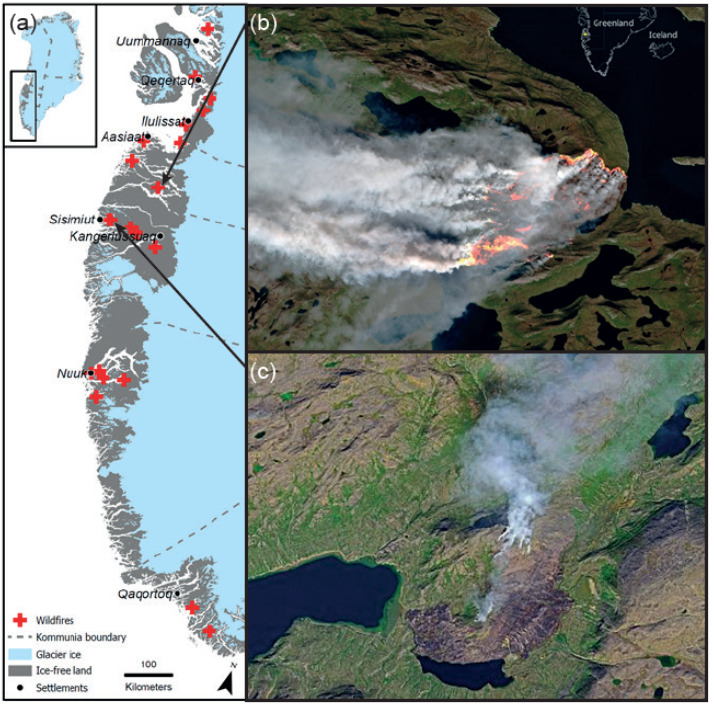Harold Lovell and Mark Hardiman (University of Portsmouth) travelled to Greenland in September 2023 to conduct workshops and interviews in collaboration with Pelle Tejsner (Ilisimatusarfik/University of Greenland), funded by the United Kingdom & Greenland Arctic Research Bursaries Scheme.
The purpose of our fieldwork was to explore community knowledge of wildfires in the region, which came to international prominence after two unusually large fires in 2017 and 2019 (Figure 1). Our previous work has helped to establish a history of at least 21 fires in western Greenland since 2008 (Gosden et al., 2022: https://doi.org/10.1071/WF22063) using satellite imagery and news reports in Sermitisiaq, the Greenlandic national newspaper (Figure 1a). However, it is likely our approach missed some fires, and it also fails to capture the impact of such events on the local community. To address this, we held workshops and interviews with key participants in Nuuk and Sisimiut, including members of the fire service, national museum, local residents, and representatives of the tourism industry.

Through the workshops and interviews, which involved participatory mapping exercises (Figure 2), several landscape fires were identified that we were not previously aware of, including at least two fires in the 1980s. The experience of fires was very strong in Sisimiut, which was close to the large 2019 fire (Figure 1c) and affected badly by smoke for the duration of the nearly two months of burning. Here, the fire service recognised a step-change in fire activity in around 2015, with no wildfires of note to report before this.
Figure 2. Images from the participatory mapping workshops held in Nuuk and Sisimiut
A common theme that emerged was just how dry the landscape was for several summers around this time; local residents recalled swimming in the fjord in just swimming trunks and lake levels being extraordinarily low – in one particular case, too low for the firefighters to use a lake as a water source when fighting a fire. Firefighting was very challenging because of the remote locations, mountainous terrain and sometimes great distance from water sources. The large 2019 fire mostly burned as a ground fire, whereby the peat smouldered beneath the ground. This made conventional firefighting practices of surface water spraying largely ineffective, and a specialist team from Denmark eventually had to be brought in.
It was made clear to us that the fires installed a collective heightened awareness of fire risk when the landscape is very dry, and the experience gained by the fire services when fighting these fires has made them better prepared for such events in the future.
Harold Lovell, Mark Hardiman and Pelle Tejsner
Reference
Gosden, B., Lovell, H., & Hardiman, M. (2022). Wildfire incidence in western Kalaallit Nunaat (Greenland) from 1995 to 2020. International Journal of Wildland Fire, 31(11), 1033-1042 (https://doi.org/10.1071/WF22063)

